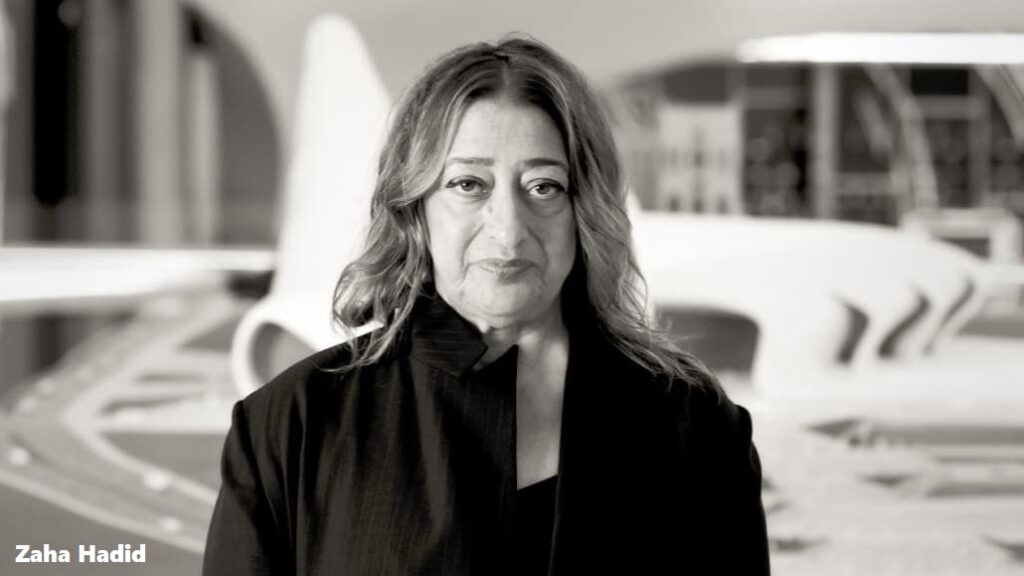Zaha Hadid- Iraqi-British Famous Architect And Painter

Zaha Hadid, dressed as a Dame British architect Zaha Hadid, who was born in Baghdad, Iraq, on October 31, 1950, and passed away in Miami, Florida, on March 31, 2016, was best known for her avant-garde deconstructivist works. She received the Pritzker Architecture Prize for the first time in 2004.
Also Read: –A Ultimate Guide to Urban Street design
Zaha Hadid Early life and Career
Hadid enrolled in the American University in Beirut, Lebanon, where she graduated with a bachelor’s in mathematics. She went to London in 1972 to attend the Architectural Association, a significant hub of avant-garde architectural ideas in the 1970s. There, she made the acquaintance of the designers Rem Koolhaas and Elia Zenghelis, with whom she later joined forces to form the Office of Metropolitan Architecture. In 1979, Hadid founded Zaha Hadid Architects (ZHA), a business in London.
- She joined the “Office of Metropolitan Architecture” and started teaching at the “Architectural Association” in 1977, marking the beginning of her illustrious career.
- Hadid gained her independence in 1980 and started her own practise in London. Today, “Zaha Hadid Architects” has around 350 employees.
- The “Vitra Fire Station” in Weil am Rhein, Germany, was her first successfully completed construction project. From 1989 until 1993, the project was underway. Since then, a museum has been housed in the structure.
- Her concept was chosen in 1994 for the Cardiff Bay Opera House in Wales. She gained considerable notoriety and renown as a result, but regrettably the city decided to build a stadium rather than authorise the building’s construction.
- The selection of her design for the “Rosenthal Center for Contemporary Art” in 1998 marked a significant accomplishment. This was her debut project in America, and it was recognised with two awards: the “American Architecture Award” from “The Chicago Athenaeum” in 2005 and the “Royal Institute of British Architects Award” in 2004.
- In the 1990s, she held the Sullivan Chair professorship in the School of Architecture at the University of Illinois at Chicago. She also served as a visiting professor at a number of universities, including the Masters Studio at Columbia University, the Knowlton School of Architecture at Ohio State University, and the Hochschule für bildende Künste Hamburg (HFBK Hamburg).
- Her proposal for the “Olympic Aquatic Center” for the “2012 Olympic Games” was chosen in 2005. At the moment, her creations are planned to be implemented during the “Tokyo 2020 Olympic Games.”
Quick Facts
British Celebrities Born In October
Died At Age: 65
Family:
Siblings: Fulath Hadid, Haithem Hadid
Died On: March 31, 2016
Place Of Death: Miami, Florida, United States
City: Baghdad, Iraq
With her winning entry for The Peak, a leisure and entertainment centre in Hong Kong, Hadid won a competition and attracted attention from all over the world in 1983. Her aesthetic, which was influenced by Kazimir Malevich and the Suprematists, was defined by this design, a “horizontal skyscraper” that travelled at a dramatic diagonal down the hillside site. Her forceful geometric designs are marked by a sense of fragmentation, instability, and movement. She was categorised alongside “deconstructivist” architects because of her disjointed aesthetic, a label popularised by the historic 1988 exhibition “Deconstructivist Architecture” exhibited at the Museum of Modern Art in New York City.
The majority of Hadid’s avant-garde ideas from the 1980s and the early 1990s, such as those for the Kurfürstendamm in Berlin in 1986, the Düsseldorf Art and Media Centre in 1992–1993, and the Cardiff Bay Opera House in Wales in 1994, were never built, including her vision for The Peak. Hadid gained the reputation of being a “paper architect,” which denoted that her creations were too avant-garde to progress past the drawing stage and be truly constructed. This opinion of her was strengthened when her exquisitely produced designs—often presented as painstakingly detailed coloured paintings—were displayed as works of art in prestigious museums.
The Vitra Fire Station in Weil am Rhein, Germany, was Hadid’s first significant construction undertaking (1989–1993). The building, which is made up of several sharply angled planes, looks like a bird in flight. Her other constructed works from this time period include the Land Formation One exhibition space (1997–99) in Weil am Rhein, the Mind Zone exhibition space (1999) at the Millennium Dome in Greenwich, London, and a housing project for IBA Housing (1989–93) in Berlin. In each of these endeavours, Hadid deepened her exploration of her passion for building dynamic sculptural architecture and linking spaces.
When construction of her new Lois & Richard Rosenthal Center for Contemporary Art in Cincinnati, Ohio, started in 2000, Hadid cemented her name as an architect of built works. The 85,000 square foot (7,900 square metre) centre, which debuted in 2003, was the first museum in America that a woman had developed. The museum, which is essentially a vertical succession of cubes and voids, is situated in the heart of Cincinnati’s downtown. The façade of the museum is made of translucent glass on the side that faces the street, which dispels the idea that it is a cold or distant place by allowing visitors to peek inside. After the visitor enters the building, the structure’s layout softly slopes upward; Hadid expressed the aim that this would create a “urban carpet” that invites people inside the museum.
The Royal Institute of British Architects (RIBA) awarded Hadid the Stirling Prize in 2010 for the most innovative and audacious British architectural design for the MAXXI museum of contemporary art and architecture in Rome. The next year, she received a second Stirling Prize for a modern building she designed for the secondary school Evelyn Grace Academy in London. The Heydar Aliyev Center, an Azerbaijani cultural centre that debuted in 2012, was designed by Hadid and earned the 2014 Design of the Year award from the London Design Museum. She was the first female recipient of that prize, which honours the best designs in the categories of architecture, furniture, fashion, graphics, products, and transportation. Other major projects she completed were the London Aquatics Centre for the 2012 Summer Olympics, the Eli and Edythe Broad Art Museum at Michigan State University in East Lansing, Michigan, and the Jockey Club Innovation Tower for the Hong Kong Polytechnic University.
Hadid’s amazing accomplishments were all the more impressive in light of the fact that she worked in a field that was predominately male. Her backers argued that she frequently faced controversies that her male coworkers did not. The extravagant cost and size of many of her commissions were routinely made fun of, as were her strange forms. In fact, Hadid’s design for the New National Stadium for the 2020 Olympics in Tokyo had to be completely scrapped due to rising criticism, particularly from prominent Japanese architects, due to the problematic site for the London Aquatics Center (the Olympics were later postponed because of the coronavirus pandemic). There was more criticism after it was revealed in a 2014 study that Qatar, the country hosting the 2022 World Cup, had lost 1,000 foreign employees to unsafe working conditions on building sites. Hadid objected to her obligation as an architect to maintain safe working conditions when asked about the deaths, and her comments were widely viewed as disrespectful. A New York Review of Books architecture critic made a bogus allegation that 1,000 people had perished building her stadium when it hadn’t even broken ground, which made the issue worse. Hadid sued the critic and the publisher for defamation. Later, she made amends, accepted an apology, and gave the undisclosed amount to a group that defends labour rights.
Hadid has taught architecture at numerous institutions, including Yale University, Harvard University, the Architectural Association, and the University of Chicago. In addition, she created theatrical sets, including one for the 2014 Los Angeles Philharmonic staging of Wolfgang Amadeus Mozart’s Cosi fan tutte, as well as furniture, jewellery, shoes, and purses.
36 unfinished projects, including the 2022 World Cup stadium, the Antwerp Port House (2016), and the King Abdullah Petroleum Studies and Research Centre (KAPSARC) in Riyadh, Saudi Arabia, were left by Hadid when she unexpectedly passed away from a heart attack while receiving treatment for bronchitis in 2016. Patrik Schumacher, her business partner, took over as the company’s CEO, ensuring the fulfilment of existing commissions and the acquisition of new ones.
Also Read:- 10 Things to Remember While Designing Shopping Malls & Complex
In addition to the Pritzker Prize and the Stirling Prize, she received numerous honours, such as the Royal Gold Medal for Architecture (2016), the highest award given by the RIBA, and the Praemium Imperiale prize for architecture from the Japan Art Association in 2009. Hadid served on the Editorial Board of Advisors for Encyclopaedia Britannica (2005–06). She received the title of Dame Commander of the British Empire in 2012. (DBE).
FAQs
When was Zaha Hadid born and when did she die?
At the age of 65, Zaha Hadid passed away on March 31, 2016, in Miami. She was born on October 31, 1950, in Baghdad.
What was Zaha Hadid known for?
Architect Zaha Hadid was renowned for her avant-garde deconstructivist creations. In 2004, she became the first woman to receive the Pritzker Architecture Prize. Her constructions include the MAXXI museum of modern art and architecture in Rome and the Heydar Aliyev Centre in Baku, Azerbaijan.
Where was Zaha Hadid educated?
Later, Zaha Hadid attended an English boarding school after attending a Catholic school. She graduated with a mathematics bachelor’s degree from the American University of Beirut. She started her studies at the Architectural Association in 1972, which is a significant hub of modernist architectural theory in London.
How did Zaha Hadid become famous?
With her unique painted submission for The Peak, a recreation centre in Hong Kong, Hadid won international acclaim in 1983. After the Lois & Richard Rosenthal Centre for Contemporary Art in Cincinnati, Ohio (2003), one of her first constructed pieces, became a success, Hadid received more significant projects and developed riskier structures.
What was Zaha Hadid’s family like?
A family from the upper middle class gave birth to Zaha Hadid. Her mother, Wajiha Sabunji, was an artist, and her father, Mohammed, was a politician. Haytham and Foulath, the latter of whom was a renowned intellectual, were Zaha’s two older brothers. Although Zaha never got married or had kids, she did have a lot of nieces and nephews, including architect Rana.







